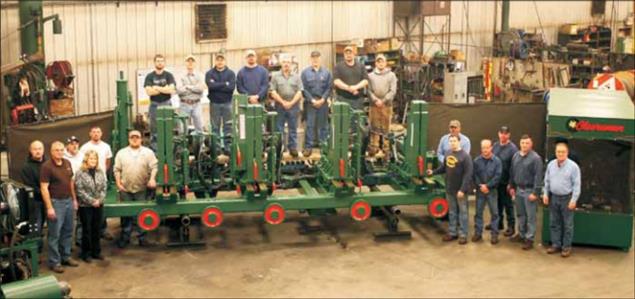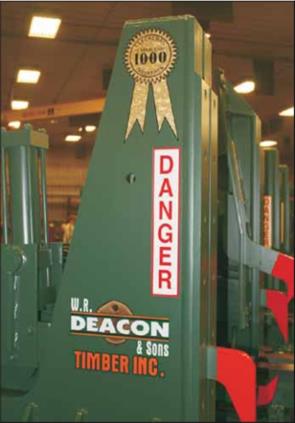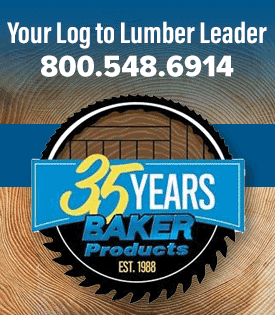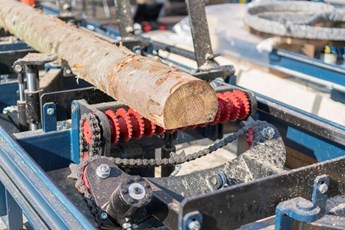Cleereman-Industries-Completes-Sawmill-Carriage-No-1-000

Back in 1989, The Cleereman-Jacquet Lumber Company was doing business in Green Bay. Brother-in-law Bill Cleereman and John Jacquet were the principal players in the operation. The company purchased land in the newly-formed Forest County near Newald, and from their logging camps, logs were sawed and given a sleigh ride to the Soo Line Railroad and after a change of railroads arrived at their mill. The Chicago & Northwestern Railroad was building a north-south line in the years that followed, reach Wabeno in 1897 and finally laying track through Newald in 1911.
The Cleereman-Jacquet Lumber company packed everything up and moved their operation north to Newald, and built a steam-powered sawmill, housing, barns, camps and all of the infrastructure needed to run a sawmill and logging operation.
Francis Cleereman was born in Newald, raised around the sawmill and all of the characters that went with a business in the wilds of northern Wisconsin. He learned much about millwrighting from a fellow named Tom Kleve, graduated from high school in Laona and went on to serve his country in the Army in the European Theatre in WWII. When his stint in the war ended, he came back to Newald and went to work. The Jacquet family was no longer involved in the business after the war, and Bill Cleereman was the sole owner.
But, sawmilling had changed through the years. The business was more competitive, and according to Francis, in an interview with him 20 years ago, his father, Bill Cleereman decided in the early 1950's that it was fruitless to run the mill anymore, but Francis had some ideas. One of those ideas was to modernize the sawmill carriage and eliminate the people it took to handle a log on a carriage. No longer would there be someone riding the carriage back and forth all day long, logs were turned and positioned by an operator, the head sawyer, sitting in a booth using the buttons at his fingertips to use electricity and compressed air to do the work that used to require three men.
Francis Cleereman had no idea at the time that he had started a revolution in how sawmills would be run. The beginning of this revolution came when Francis looked out of the millwright's shop and saw a man watching the carriage work. Thinking he was a lumber buyer, he stepped out to see if he could be of help. This Upper Peninsula sawmill operator had heard of the new Cleereman automated carriage and after watching it for a few minutes, decided he had to have one. Francis, however, had a different idea. He told him that they were sawmill operators and not manufacturers of sawmill equipment. A heated argument ensued, and then his father showed up. He told his son that he had plenty of time to make a mill and, after all, he was going to be paid to do it. Francis made the mill, then was accosted by another mill owner who wanted the new technology. The easy days of keeping the Cleereman sawmill were over. The word spread, and by 1969, the Cleereman sawmill carriage was the industry model of excellence that all of his competitors strived for.
1969 is also the year that the Cleereman family left the lumber business. The first Saturday of October, Bill Cleereman suddenly passed away, and Francis said they never sawed another board.
Sons Fran and John joined their father in the business, and they continued to supply sawmill carriages to sawmill men throughout the United States and Canada.
As the years passed, the two brothers and their father continued to work on the original design, improving whenever and wherever they could, meeting the needs of the sawmill industry. Time caught up with Francis eventually, and he passed away, leaving the business in the hands of two sons who were also very adept at making mills and designing new innovations.
That is still the case at Cleereman Industries in Newald. Since then, John retired from the business, and Fran took on two new investors and helpers, Jeff Krueger and Rod Chitko.
Like their predecessors in the business, they are always looking for new and better ways to serve the sawmill industry. After surviving the economic collapse of 2008, when much of the work in the shop was the repairing of used carriages for owners who might have wanted to buy new but didn't want the debt. Things have changed in recent times. When you look at the chalkboard listing upcoming projects, you are looking at a year's work building sawmill equipment.
The gang at Cleereman Industries isn't done with innovation either. They now offer whole systems, not just a sawmill carriage and the saw. With any mill, there is also a vast array of machines to handle materials and keep the flow of lumber, slabs and sawdust moving away from the saw and into the proper places. They also offer a new type of mill.
The new Lumber Pro model breaks with the traditions of a carriage carrying the log through the saw. Instead, the saw moves through the log. There is no longer a moving carriage, but a place to rest the log and turn it as the saw moves back and forth. The three manufacturers, Fran, Jeff and Rod explained that this system is more energy and operator efficient, with up to $600 savings on the electrical bill in some instances. The Lumber Pro is also easier and quicker to install.
The 1000th Cleereman sawmill carriage milestone took 60 years to reach, and it would be impossible to estimate the board feet of lumber sawed on Cleereman equipment in that length of time. My guess is that you could build a boardwalk to the moon.
The owner of this mill is W.R. Deacon and Sons from Lexington, Virginia. He is trading in a 1995 model for the new one, not because it has worn out, but he wants to leave his mill to his sons, and wants them to start out with a new Cleereman system. He bought his first back in 1987, and he knows they work. Fran said they will do some work on his trade-in and sell it to another owner.
There is one exception to the technological advancements made at this Forest County company. That is the Amish market. They seem to like the Cleereman carriages very much, but they won't use electricity and always want the old designs that started this march to mill number 1000, and they use a diesel engine to power it. They still work as well as the did 60 years ago.
When visiting the Cleereman plant in Newald, I thought back to when I did a history on the Cleereman sawmill carriage twenty years ago and spent time with its inventor, Francis Cleereman. He was a pugnacious man with an unlimited work ethic, but he also had a great joy in being the cantankerous old guy who loved to pick arguments with his sons, even if he secretly agreed with them. I might add that they also liked the exchange and often started the argument. I thought that Francis would be extremely proud of this company that he had begrudgingly started at the insistence of his father, but he probably wouldn't admit it.
By Mike Monte, Editor, Pioneer Express





